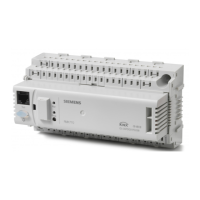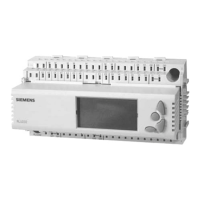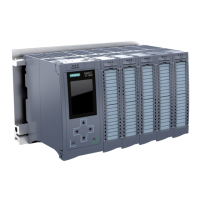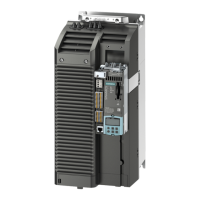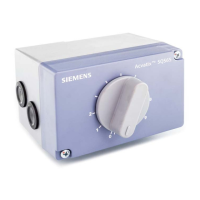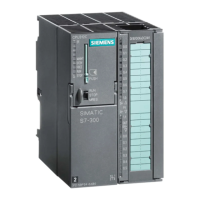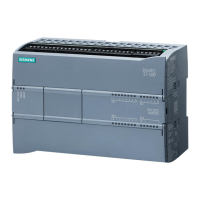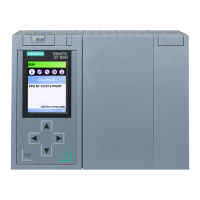Do you have a question about the Siemens Synco 700 Series and is the answer not in the manual?
Details the available units and their product numbers in the Synco™ 700 series.
Illustrates the network connections between controllers, operator units, and other devices.
Lists compatible sensors, room units, and actuators with their technical data.
Provides a list of related documents for Synco™ 700 products with classification numbers.
Contains crucial information on safety, field of use, installation, operation, and disposal.
Describes operating elements on the controller and extension module without an operator unit.
Covers functions, operating concept, levels, and access rights for operator units.
Explains the fundamental principles of boiler sequencing and plant types.
Details the initial steps and menu structure for entering commissioning mode.
Covers essential settings like plant type and extension module assignments.
Allows adaptation of hydraulics, extra functions, and activation of function blocks.
Describes how to use multiple RMK770 controllers for complex boiler sequences.
Guides on testing inputs and outputs to identify wiring or configuration errors.
Explains how to exit commissioning mode and start the plant.
Details how to store and restore the configuration and settings.
Provides information about the controller, such as software and hardware versions.
Shows terminal assignments for various plant types.
Covers setting the time, date, and summer/winter time changeover.
Explains how to select the display language for the controller.
Details how to switch between Celsius (°C) and Fahrenheit (°F) units.
Describes how to adjust the display contrast for better readability.
Covers setting device names, file names, and fault texts.
Describes the time switch functionality for automatic heating circuit operation.
Explains how to enter days deviating from the normal 7-day program.
Details how to activate frost protection for the plant and pumps.
Covers activating overtemperature protection for pumps and mixing valves.
Explains protective functions to prevent seizing of pumps and valves.
Describes how heat demand signals are managed and load control is applied.
Covers control parameters and setting aids for mixing valves.
Details hours run counter, pump supervision, twin pumps, changeover logic, and overload.
Presents a diagram of the Boiler Sequence Manager function block and its inputs/outputs.
Explains how the Boiler Sequence Manager is activated and configured.
Details the concept, control parameters, and operation settings for boiler sequencing.
Covers monitoring faults for the main pump and boiler sequence.
Explains how heat demand and requests are handled by the system.
Covers common maintained boiler return temperature, flow temperature limits, and frost protection.
Describes how to access and interpret diagnostic information.
Details fault messages and handling procedures for various components.
Presents the BoCtrl function block diagram with inputs and outputs.
Explains basic and extra configuration for boilers, including burner types and hydraulics.
Describes how to configure additional boilers beyond the basic setup.
Covers selecting operating modes and understanding boiler setpoints.
Details how to release or lock boilers via digital inputs or operating mode.
Explains how to configure and use individual operation for a boiler.
Describes how to use test modes for boilers and burners.
Covers 2-position control for 1-stage and 2-stage burners, and modulating burner control.
Details functions like maximum/minimum temperature limits and boiler startup.
Explains how to monitor flue gas temperature and related fault messages.
Describes how to activate and use the flue gas measuring mode.
Lists common boiler faults, their causes, and effects.
Covers tracking burner operating hours and calculating output balance.
Lists various fault status messages for boilers and their effects.
Explains how to assign specific designations to boilers.
Lists available diagnostic parameters for boilers and inputs/setpoints.
Describes sources of heat requests and how they are delivered.
Explains using a virtual heating circuit for weather-compensated setpoints.
Details how heat demand transformers convert signals to flow temperature setpoints.
Presents the Precontrol function block diagram and its configuration.
Explains the activation and configuration of the Primary controller function block.
Describes Type 1 (with mixing valve) and Type 2 (with system pump) primary controllers.
Indicates if the primary controller is switched on and if the pump runs.
Covers how the Primary controller collects heat demand signals.
Details mixing valve control settings and load control influence.
Explains setpoint boost for compensating temperature fluctuations.
Covers frost protection, temperature limitations, and pulse limitation.
Lists fault numbers, texts, and effects for primary controller and system pump faults.
Lists diagnostic parameters for primary controller inputs and outputs.
Presents the heating circuit function block diagram and its components.
Explains activating the heating circuit function block via extra configuration.
Details room operating modes (Auto, Comfort, Precomfort, Economy, Protection).
Covers overriding the 24-hour program and using room units like QAW740.
Explains using a configurable input for changing the room operating mode.
Describes how a timer function can extend Comfort mode operation.
Details how operating modes can be sent to relays for external signaling.
Indicates if the heating circuit is switched on and if the pump operates.
Shows the priority hierarchy for different control interventions.
Covers settings for room operating modes and remote setpoint adjusters.
Explains determining flow temperature setpoints based on outside temperature.
Describes how to restrict heat delivery to prevent energy waste.
Details control parameters and load control for mixing valves.
Covers functions like optimum start/stop, quick setback, and boost heating.
Includes maximum room temperature limitation and return temperature limitation.
Explains how to limit heat output using pulses from meter inputs.
Details frost protection for the plant/flow and heating up brake.
Describes how heat demand signals are connected and parameterized.
Lists fault messages for heating circuit sensors and pumps.
Lists available diagnostic parameters for heating circuit inputs and outputs.
Explains time-related recording of measured values using trend channels and views.
Describes fault handling related to trend signals and power failures.
Covers meter configuration, types, pulse valency, overflow, and readings.
Explains how to assign specific texts to meters for display.
Details fault handling for meters, particularly no pulse signal messages.
Presents the Miscellaneous function block and its configuration options.
Details connecting and using outside sensors for various functions.
Covers configuring universal inputs for display purposes.
Explains activating and configuring the outside temperature relay.
Lists diagnostic options for miscellaneous inputs and outputs.
Describes the task of the Faults function block in collecting and evaluating fault messages.
Explains configuring fault inputs and fault relays.
Details how fault status messages are indicated by the LED on the fault button.
Describes the optional connection and function of an external fault button.
Covers fault distinctions regarding acknowledgement, reset, priority, and plant behavior.
Illustrates state diagrams for simple, standard, and configured fault relays.
Lists predefined fault inputs for various function blocks.
Details universal fault inputs and their configuration.
Explains monitoring analog inputs for limit value crossings.
Describes the impact of communication on fault handling and remote acknowledgement.
Covers configuring fault relays for signaling fault status messages.
Explains how to view current faults, fault history, and fault status messages.
Details how to delete fault history and reset pending fault status messages.
Describes how to switch fault status inputs during wiring tests.
Lists diagnostic options for fault-related inputs and outputs.
Covers essential settings like device address, power supply, and clock time operation.
Explains using the RMK770 calendar or another Synco™ 700 device's calendar.
Details communication variants for room data exchange.
Explains the importance of zones for data exchange in boiler sequences.
Describes heat distribution zones for heat demand and load control signals.
Covers exchanging outside temperature signals via zones.
Lists fault messages related to bus power, clock time, system time switch, and room master.
Provides a comprehensive list of fault numbers and their corresponding explanations.
Offers solutions for common fault scenarios and troubleshooting questions.
Includes terminal markings, code letters, and configuration choices.
Lists editable texts for boiler sequence manager, boilers, primary controller, and heating circuit.
Outlines the structure of the controller's menu system.
Describes how to access and navigate through various Info pages.
Details the available units and their product numbers in the Synco™ 700 series.
Illustrates the network connections between controllers, operator units, and other devices.
Lists compatible sensors, room units, and actuators with their technical data.
Provides a list of related documents for Synco™ 700 products with classification numbers.
Contains crucial information on safety, field of use, installation, operation, and disposal.
Describes operating elements on the controller and extension module without an operator unit.
Covers functions, operating concept, levels, and access rights for operator units.
Explains the fundamental principles of boiler sequencing and plant types.
Details the initial steps and menu structure for entering commissioning mode.
Covers essential settings like plant type and extension module assignments.
Allows adaptation of hydraulics, extra functions, and activation of function blocks.
Describes how to use multiple RMK770 controllers for complex boiler sequences.
Guides on testing inputs and outputs to identify wiring or configuration errors.
Explains how to exit commissioning mode and start the plant.
Details how to store and restore the configuration and settings.
Provides information about the controller, such as software and hardware versions.
Shows terminal assignments for various plant types.
Covers setting the time, date, and summer/winter time changeover.
Explains how to select the display language for the controller.
Details how to switch between Celsius (°C) and Fahrenheit (°F) units.
Describes how to adjust the display contrast for better readability.
Covers setting device names, file names, and fault texts.
Describes the time switch functionality for automatic heating circuit operation.
Explains how to enter days deviating from the normal 7-day program.
Details how to activate frost protection for the plant and pumps.
Covers activating overtemperature protection for pumps and mixing valves.
Explains protective functions to prevent seizing of pumps and valves.
Describes how heat demand signals are managed and load control is applied.
Covers control parameters and setting aids for mixing valves.
Details hours run counter, pump supervision, twin pumps, changeover logic, and overload.
Presents a diagram of the Boiler Sequence Manager function block and its inputs/outputs.
Explains how the Boiler Sequence Manager is activated and configured.
Details the concept, control parameters, and operation settings for boiler sequencing.
Covers monitoring faults for the main pump and boiler sequence.
Explains how heat demand and requests are handled by the system.
Covers common maintained boiler return temperature, flow temperature limits, and frost protection.
Describes how to access and interpret diagnostic information.
Details fault messages and handling procedures for various components.
Presents the BoCtrl function block diagram with inputs and outputs.
Explains basic and extra configuration for boilers, including burner types and hydraulics.
Describes how to configure additional boilers beyond the basic setup.
Covers selecting operating modes and understanding boiler setpoints.
Details how to release or lock boilers via digital inputs or operating mode.
Explains how to configure and use individual operation for a boiler.
Describes how to use test modes for boilers and burners.
Covers 2-position control for 1-stage and 2-stage burners, and modulating burner control.
Details functions like maximum/minimum temperature limits and boiler startup.
Explains how to monitor flue gas temperature and related fault messages.
Describes how to activate and use the flue gas measuring mode.
Lists common boiler faults, their causes, and effects.
Covers tracking burner operating hours and calculating output balance.
Lists various fault status messages for boilers and their effects.
Explains how to assign specific designations to boilers.
Lists available diagnostic parameters for boilers and inputs/setpoints.
Describes sources of heat requests and how they are delivered.
Explains using a virtual heating circuit for weather-compensated setpoints.
Details how heat demand transformers convert signals to flow temperature setpoints.
Presents the Precontrol function block diagram and its configuration.
Explains the activation and configuration of the Primary controller function block.
Describes Type 1 (with mixing valve) and Type 2 (with system pump) primary controllers.
Indicates if the primary controller is switched on and if the pump runs.
Covers how the Primary controller collects heat demand signals.
Details mixing valve control settings and load control influence.
Explains setpoint boost for compensating temperature fluctuations.
Covers frost protection, temperature limitations, and pulse limitation.
Lists fault numbers, texts, and effects for primary controller and system pump faults.
Lists diagnostic parameters for primary controller inputs and outputs.
Presents the heating circuit function block diagram and its components.
Explains activating the heating circuit function block via extra configuration.
Details room operating modes (Auto, Comfort, Precomfort, Economy, Protection).
Covers overriding the 24-hour program and using room units like QAW740.
Explains using a configurable input for changing the room operating mode.
Describes how a timer function can extend Comfort mode operation.
Details how operating modes can be sent to relays for external signaling.
Indicates if the heating circuit is switched on and if the pump operates.
Shows the priority hierarchy for different control interventions.
Covers settings for room operating modes and remote setpoint adjusters.
Explains determining flow temperature setpoints based on outside temperature.
Describes how to restrict heat delivery to prevent energy waste.
Details control parameters and load control for mixing valves.
Covers functions like optimum start/stop, quick setback, and boost heating.
Includes maximum room temperature limitation and return temperature limitation.
Explains how to limit heat output using pulses from meter inputs.
Details frost protection for the plant/flow and heating up brake.
Describes how heat demand signals are connected and parameterized.
Lists fault messages for heating circuit sensors and pumps.
Lists available diagnostic parameters for heating circuit inputs and outputs.
Explains time-related recording of measured values using trend channels and views.
Describes fault handling related to trend signals and power failures.
Covers meter configuration, types, pulse valency, overflow, and readings.
Explains how to assign specific texts to meters for display.
Details fault handling for meters, particularly no pulse signal messages.
Presents the Miscellaneous function block and its configuration options.
Details connecting and using outside sensors for various functions.
Covers configuring universal inputs for display purposes.
Explains activating and configuring the outside temperature relay.
Lists diagnostic options for miscellaneous inputs and outputs.
Describes the task of the Faults function block in collecting and evaluating fault messages.
Explains configuring fault inputs and fault relays.
Details how fault status messages are indicated by the LED on the fault button.
Describes the optional connection and function of an external fault button.
Covers fault distinctions regarding acknowledgement, reset, priority, and plant behavior.
Illustrates state diagrams for simple, standard, and configured fault relays.
Lists predefined fault inputs for various function blocks.
Details universal fault inputs and their configuration.
Explains monitoring analog inputs for limit value crossings.
Describes the impact of communication on fault handling and remote acknowledgement.
Covers configuring fault relays for signaling fault status messages.
Explains how to view current faults, fault history, and fault status messages.
Details how to delete fault history and reset pending fault status messages.
Describes how to switch fault status inputs during wiring tests.
Lists diagnostic options for fault-related inputs and outputs.
Covers essential settings like device address, power supply, and clock time operation.
Explains using the RMK770 calendar or another Synco™ 700 device's calendar.
Details communication variants for room data exchange.
Explains the importance of zones for data exchange in boiler sequences.
Describes heat distribution zones for heat demand and load control signals.
Covers exchanging outside temperature signals via zones.
Lists fault messages related to bus power, clock time, system time switch, and room master.
Provides a comprehensive list of fault numbers and their corresponding explanations.
Offers solutions for common fault scenarios and troubleshooting questions.
Includes terminal markings, code letters, and configuration choices.
Lists editable texts for boiler sequence manager, boilers, primary controller, and heating circuit.
Outlines the structure of the controller's menu system.
Describes how to access and navigate through various Info pages.
| Brand | Siemens |
|---|---|
| Model | Synco 700 Series |
| Category | Controller |
| Language | English |
